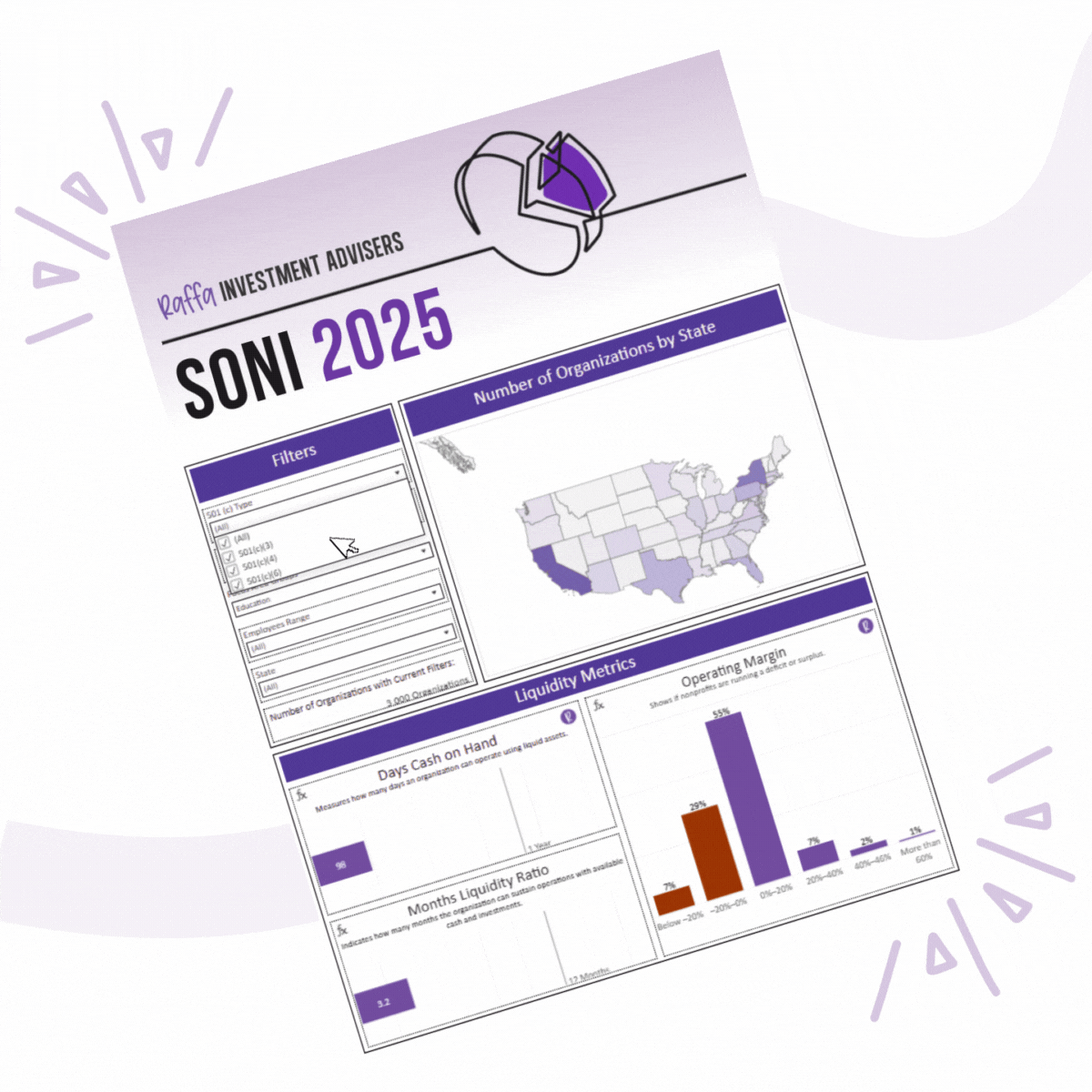What is SONI?
What’s new for 2025
SONI Upgraded. For 2025, Raffa has created an all-new peer benchmarking tool that allows users to measure how your nonprofit or association compares to your peers and industry best practices on key indicators of financial health. With enhanced peer group customization, intuitive data visualizations, and practical insights, you can now dig deeper into how your organization compares to peers nationwide.
Whether you’re building next year’s budget, preparing for a board meeting, or guiding long-term strategy, SONI puts actionable, real-time benchmarking data at your fingertips.

Benchmark Your Financial Metrics to Your Peers
Measure how your nonprofit or association compares to your peers and industry best practices on key indicators of financial health with Raffa’s Study on Nonprofit Investing (SONI) dashboard.
As a nonprofit executive, board member, or finance leader, you want confidence that your organization’s financials will meet current and short needs and enable you to be around for the long-term. It’s critical to know whether your investment policy and strategy are aligned with sector norms and tailored to your organization’s mission.
At Raffa, we recommend actively evaluating key liquidity, operational and financial measures, including:
- Days of cash on hand
- Amount of budgeted expenses held in reserve
- Liquidity
- Short-term vs. long-term investment segmentation
- Growth in total reserves over time
Every organization and its circumstances are unique, so there truly is no right answer for how much to hold in reserve. But verifying whether your nonprofit or association is in-line with other, similar organizations can help you identify and prioritize strategic, governance and operational areas that may need attention.
COMING SOON! Nonprofit and association leaders are using SONI to answer the questions their boards and finance committees are asking. Check back soon to hear what Raffa and your peers have to say about SONI.
Nonprofits and associations should invest excess cash, over the FDIC limits, in US Treasury bills, CDs, or in a money market fund backed by US Treasuries. We call this an operating or cash reserve.
Once an organization’s net assets reach a level where there’s a reliable cash cushion—more than what’s needed for operating liquidity—some of those funds can be prudently invested in intermediate-term vehicles like laddered CDs, Treasury bills, or short-term bond funds. This is often the first step in a more intentional investment strategy, even before considering equities for long-term growth.
Once an organization has a stable operating/cash reserve and intermediate-term investments in place, it may be appropriate to allocate a portion of assets to a long-term, balanced investment portfolio. These funds aren’t expected to be spent for several years, making them suitable for a strategy that balances risk and return.
In this phase, the goal shifts from simply protecting principal to preserving the real value of assets over time—accounting for inflation. That typically means adding exposure to equities alongside bonds, with a diversified mix designed to generate moderate growth while still managing volatility.
This approach helps ensure that funds maintain their purchasing power so they can
The answer to how much an organization should keep in cash vs investments depends on how certain/predictable your cash flows are. We typically recommend keeping 1 – 3 months of budgeted expenses in an operating checking account with any additional funds expected to be spent in the next 6-12 months+ in a cash/operating reserve. The greater the degree of consistent and reliable income streams, the lower the checking account cash target.
We think spending from reserves should be an ongoing consideration. Reserve assets are there to support the organization in times of operating stress, but also to further the mission of the organization, supporting its stakeholders. If there is an initiative or capital investment that was not budgeted for but would deliver value for stakeholders then we absolutely believe an organization should consider spending from its reserves to start that project.
Data Disclosure
All data presented has been sourced from Cause IQ, which aggregates information from IRS Form 990 filings and other public sources. While we believe the data to be reliable, we cannot guarantee its accuracy or completeness. The financial metrics and results shown are for informational purposes only and should not be relied upon as the sole basis for financial, investment, or operational decisions.



